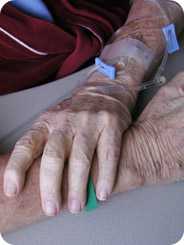New Hampshire's Success
Reducing radon exposure
![]()
What is the problem?
Radon is a natural gas that has no color or smell. New Hampshire's environment creates more radon than most states. As a result, more people are exposed. Radon causes more than 100 lung cancer deaths in New Hampshire each year. Testing for radon is cheap and could help stop these deaths. Still, more than 250,000 homes in high radon risk areas have not been tested.
What did Tracking do?
The New Hampshire Tracking Network worked with the New Hampshire Department of Environmental Services Radon Program to create a radon testing media campaign. The campaign ran in January for Radon Awareness Month. An issue brief was posted on the New Hampshire Tracking Network website. It described the link between radon risk and radon testing behavior. The New Hampshire Department of Environmental Services sent out a news release to offer free radon test kits to the community.
Improved public health
The New Hampshire Department of Environmental Services gave out thousands of free radon test kits to residents. The New Hampshire Environmental Public Health Tracking Program responded to requests on how to reduce radon exposure. The Tracking Program continues to hold radon awareness events with public health officials and in the community. Plus, the Tracking Program now uses its Environmental Health Data Integration Network to track and check for trends in lung cancer cases.
Measuring the Impact of Climate Change

What is the problem?
New Hampshire's climate is changing because of greenhouse gas emissions. Greenhouse gases come from daily activities like driving a gasoline powered car or using a lawnmower. As a result of climate change, scientists are now seeing warmer winters, less snowfall, rising sea levels, more rainfall, and more floods. These kinds of changes may affect New Hampshire's natural resources over time and could cost the state millions of dollars in lost revenue.
What did Tracking do?
The New Hampshire Tracking Network helped the Governor's Climate Change Policy Task Force describe the effects climate change could have on NH. The results were printed in the New Hampshire Climate Action Plan: A Plan for New Hampshire's Energy, Environmental and Economic Development Future.
The plan identifies policies and actions needed to help people and groups who could be most affected. The New Hampshire Department of Environmental Services also worked with the New Hampshire Division of Public Health Services to develop a Climate Change and Public Health Adaptation Plan for New Hampshire. This was paid for by a grant from the Association of State and Territorial Health Officials.
Improved public health
The New Hampshire Tracking Network is now developing indicators to track illness, death, and people or groups most affected by climate change. These data will help New Hampshire respond to and evaluate future public health issues caused by environmental changes. This information will be placed on the New Hampshire Tracking Program Web site.
Improving melanoma reporting measures

What is the problem?
In the U.S., melanoma rates have tripled over the past two decades. In New Hampshire, the rates have also gone up and appear to be higher than the national rate. Melanoma is a form of skin cancer. It is often linked to ultraviolet radiation (UV) from the sun and tanning equipment. Many New Hampshire public health officials are concerned about the growing number of melanoma cases. As a result, they asked the NH Tracking Program for a review of the data to see if it was correct. They also wanted to identify people who are most at risk.
What did Tracking do?
The New Hampshire Tracking Network staff worked with the New Hampshire Cancer Registry to review state and national melanoma data. The review found melanoma cases were underreported in the past. The use of incorrect data may have caused the melanoma rates to seem higher. Researchers did find that young women in New Hampshire have a 38% higher rate of melanoma than other groups nationwide.
Improved public health
The New Hampshire Tracking Network published the findings in an issue brief. Public health education meetings were also held with state health officers and other interested groups about the rise in melanoma cases. The New Hampshire Tracking Network published articles in state print media to promote melanoma awareness, with an emphasis on UV exposure reduction, especially for at-risk populations such as young women and elderly men.
New Hampshire's Grantee Profile
[PDF 347 KB]- Page last reviewed: January 3, 2014
- Page last updated: August 10, 2011
- Content source:


 ShareCompartir
ShareCompartir